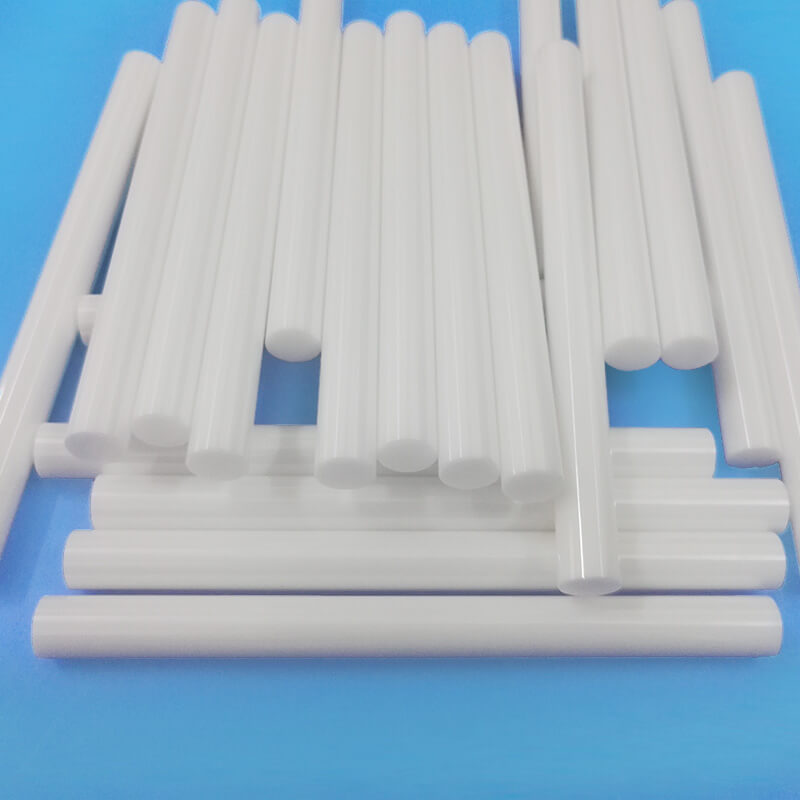Introduction to Zirconia Ceramic Materials
Zirconia, a precision ceramic material with high mechanical strength and fracture toughness, is used in blades, shears, cutting tools, and pump components. Its thermal and chemical stability makes it essential for high-temperature and corrosive environments in aerospace, automotive, and electronics industries.
E-mail:sales01@hkceramic.com

| Plate material mm (L, H, and W can be selected as needed, customization supported) | ||||||||||||
| L | 3 | 5 | 8 | 10 | 12 | 15 | 18 | 20 | 22 | 25 | 28 | More (Customizable) |
| W*H | 100*100 | 90*140 | 95*145 | 150*150 | 160*160 | 122*290 | 110*275 | More (Customizable) | ||||
| Rod material mm (W, Ø can be selected as needed, customization supported) | ||||||||||||
| Ø | 0.5 | 0.8 | 0.9 | 1 | 1.5 | 2 | 2.5 | 3 | 3.5 | 4 | 4.5 | More (Customizable) |
| W | 60 | 100 | 120 | 200 | More (Customizable) | |||||||
Zirconia (Zirconium dioxide, ZrO2) is a highly unique and valuable ceramic material, possessing a variety of remarkable properties.
1. Outstanding Mechanical Performance and Applications
Zirconia (Zirconium dioxide, ZrO2) exhibits superior mechanical characteristics compared to alumina, including higher strength and fracture toughness. These properties make zirconia an ideal choice for many industrial applications, especially in environments requiring materials to withstand extreme forces and wear.
- High Strength and Fracture Toughness: Zirconia surpasses many traditional ceramic materials in strength and toughness, allowing it to remain stable under impact and stress, reducing the risk of fracture.
- Industrial Applications: Due to its high strength and wear resistance, zirconia is commonly used in manufacturing various high-performance industrial components such as parts in milling machines, sliding components, and cutting tool blades. These applications often demand materials capable of withstanding repeated mechanical stress without failure.
2. Excellent Thermal Insulation and Low Thermal Conductivity
Zirconia also boasts excellent thermal insulation properties, with significantly lower thermal conductivity compared to other ceramic materials.
- Low Thermal Conductivity: Zirconia has only one-tenth the thermal conductivity of some other common ceramic materials. This characteristic makes it highly useful in applications requiring insulation or thermal management.
- Thermal Management Applications: For example, in certain chemical processing equipment and high-temperature furnaces, zirconia can be used as a thermal barrier, helping to control temperatures and protect sensitive mechanical components from overheating damage.
| Type | Unit | Zirconia | Zirconia(ZrO2-MgO) | ||
| Material | \ | 94.4% ZrO2-Y2O3 |
94% ZrO2-Y2O3 |
94% ZrO2-Y2O3 |
94.4% ZrO2-MgO |
| Colour | \ | White | Black | Blue | Yellow |
| Density | g/cm3 | 6 | 5.6 | 6 | 5.7 |
| Type | Unit | Zirconia | Zirconia(ZrO2-MgO) | ||
| Material | \ | 94.4% ZrO2-Y2O3 |
94% ZrO2-Y2O3 |
94% ZrO2-Y2O3 |
94.4% ZrO2-MgO |
| Colour | \ | White | Black | Blue | Yellow |
| Flexural Strength(20℃) | Mpa | 800 | 710 | 900 | 500 |
| Compressive Strength(20℃) | Mpa | 2000 | 2000 | 2000 | 2500 |
| Modulus of Elastic(young)(20℃) | Gpa | 200 | 210 | 220 | 250 |
| Tracture Toughness(20℃) | MPam½ | 9 | 8 | 8 | 6 |
| Poi sion’s Ratio(20℃) | \ | 0.3 | 0.3 | 0.3 | |
| Hardness HRA(20℃) | HRA | 88 | 85 | 90 | |
| Vickers Hardness(HV1) | kg/mm2 | 1175 | 1100 | 1220 | 1100 |
| Rockwell Hardness(45N) | R45N | 78 | 75 | 78 | |
| Type | Unit | Zirconia | Zirconia(ZrO2-MgO) | ||
| Material | \ | 94.4% ZrO2-Y2O3 |
94% ZrO2-Y2O3 |
94% ZrO2-Y2O3 |
94.4% ZrO2-MgO |
| Colour | \ | White | Black | Blue | Yellow |
| Thermal Expansion Coefficient | 10-6K-1 | 9.6 | 9.5 | 10 | 10 |
| Thermal Conductivity | W/mk | 2.5 | 3 | 3 | 3 |
| Thermal Shock Resistance | △T.℃ | 250 | 300 | 300 | 450 |
| Specific Heat Capacity | J/g·k | 0.46 | 0.48 | 0.46 | |
| Max working Temperature(In Oxidizing) | ℃ | 800 | 800 | 800 | 2100 |
| Type | Unit | Zirconia | Zirconia(ZrO2-MgO) | ||
| Material | \ | 94.4% ZrO2-Y2O3 |
94% ZrO2-Y2O3 |
94% ZrO2-Y2O3 |
94.4% ZrO2-MgO |
| Colour | \ | White | Black | Blue | Yellow |
| Vol une Resistivity at 20℃ | Ωcm | 1014 | 1010 | 1014 | 1014 |
| Dielectric Strength | KV/mm | 13 | 13 | 13 | 13 |
| Dielectric Constant | \ | 28 | 28 | 28 | 28 |
| Dielectric LossAngle at 20℃,1MHz20℃ | tanδ | 17*10-4 | 17*10-4 | 17*10-4 | 17*10-4 |
*For more details, please feel free to contact our company.
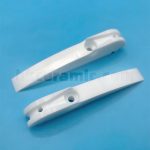
Zirconia Ceramic Dowel Pins
Material:Zirconia Ceramics
Describe:Customized zirconia (ZrO2) ceramic dowel pins, also known as mechanical industrial ceramic components. These ceramic dowel pins feature precise shapes and smooth surface designs, ensuring high precision and consistency during use. The high hardness and strength of zirconia ceramics enable these dowel pins to maintain their shape and performance unchanged even under high pressure and high friction conditions, ensuring stable...
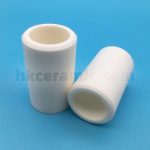
Alumina Ceramic Tube Sleeve
Material:Alumina ceramics
Describe:Alumina (Al2O3) ceramics are renowned for their physical, chemical, and electrical properties, making them ideal for high-temperature, corrosion-resistant, and high-strength applications. These tube sleeves serve as protective or insulating layers in electronics, shielding sensitive components, and in the chemical industry, handling corrosive substances. Their non-conductive nature also makes them perfect for electrical insulation.
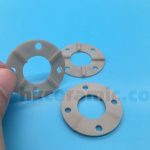
Aluminum Nitride Ceramic Discs
Material:Aluminum Nitride Ceramics
Describe:Aluminum nitride (AlN) ceramic discs offer precise perforation for mechanical support, electrical insulation, and thermal management enhancement in precision applications.
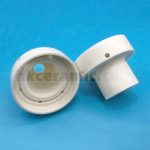
Alumina T-shaped ceramic cap
Material:Alumina ceramics
Describe:The alumina T-shaped ceramic cap combines Al2O3 material with precision engineering, offering high-temperature resistance, corrosion resistance, and electrical insulation. Its customized design ensures reliability and stability in extreme environments, meeting modern industry demands.
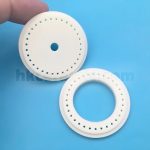
Alumina ceramic valve discs
Material:Alumina ceramics
Describe:These ceramic valve discs feature multiple precision-machined small holes for precise water flow control and filtration. The high hardness and strength of alumina ceramics enable these valve discs to maintain their shape and performance unchanged even under high pressure and high flow conditions, ensuring stability and reliability in water flow control.
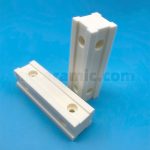
Alumina ceramic components and parts
Material:Alumina ceramics
Describe:Precision alumina (Al2O3) ceramic components for semiconductor, aerospace, medical, and precision machinery industries. They offer high load capacity, wear resistance, and chemical corrosion resistance.

